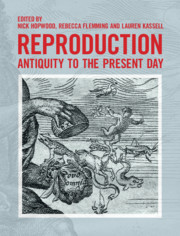Book contents
- Reproduction
- Frontispiece
- Reproduction
- Copyright page
- Dedication
- Contents
- Exhibits
- Illustrations
- Notes on the Frontispieces
- Contributors
- Acknowledgements
- Introduction
- Part I Inventing Generation
- Part II Generation Reborn and Reformed
- Part III Inventing Reproduction
- Part IV Modern Reproduction
- Part V Reproduction Centre Stage
- Epilogue
- Exhibits
- Select Bibliography
- Index
- References
Exhibits
Published online by Cambridge University Press: 16 November 2018
- Reproduction
- Frontispiece
- Reproduction
- Copyright page
- Dedication
- Contents
- Exhibits
- Illustrations
- Notes on the Frontispieces
- Contributors
- Acknowledgements
- Introduction
- Part I Inventing Generation
- Part II Generation Reborn and Reformed
- Part III Inventing Reproduction
- Part IV Modern Reproduction
- Part V Reproduction Centre Stage
- Epilogue
- Exhibits
- Select Bibliography
- Index
- References
- Type
- Chapter
- Information
- ReproductionAntiquity to the Present Day, pp. 672Publisher: Cambridge University PressPrint publication year: 2018
References
Further Reading
Chapter 2, this book.
Further Reading
Chapters 2, 3, 4 and 12 and Exhibits 9 and 13, this book.
Further Reading
Chapter 16 and Exhibit 14, this book.
Further Reading
Chapter 7 and Exhibit 40, this book.
Further Reading
Chapter 2, this book.
Further Reading
Chapters 7, 11, 19, 22 and 37 and Exhibits 10, 18 and 22, this book.
Further Reading
Chapters 4 and 7 and Exhibit 17, this book.
Further Reading
Chapters 6, 11, 12, 16 and 26 and Exhibits 4, 7, 11, 29 and 40, this book.
Further Reading
Chapters 4, 14 and 41 and Exhibits 2 and 13, this book.
Further Reading
Chapters 3, 7, 11, 16, 22 and 37 and Exhibits 6, 18, 22 and 23, this book.
Further Reading
Chapters 11, 13, 22 and 37 and Exhibits 6, 10, 17, 18 and 22, this book.
Further Reading
Chapters 2, 11, 16 and 24 and Exhibits 5, 19 and 25, this book.
Further Reading
Chapters 12, 17 and 38 and Exhibits 22, 25 and 38, this book.
Further Reading
Chapters 3, 11, 16, 31, 32 and 36 and Exhibits 3, 16, 31 and 32, this book.
Further Reading
Chapters 9, 12, 15 and 38 and Exhibits 10, 16, 23 and 34, this book.
Further Reading
Chapters 7, 14, 15 and 28 and Exhibits 15 and 20, this book.
Further Reading
Chapters 4, 11, 13, 16, 22 and 37 and Exhibits 7, 11 and 25, this book.
Further Reading
Chapters 6, 17, 24 and 33 and Exhibits 12 and 27, this book.
Further Reading
Chapters 20, 26 and 28 and Exhibits 16, 22, 23, 26 and 32, this book.
Further Reading
Chapters 15, 22 and 37 and Exhibit 22, this book.
Further Reading
Chapters 22 and 37 and Exhibits 13, 20, 21 and 25, this book.
Further Reading
Chapters 18, 23, 24, 25, 33 and 34 and Exhibits 30 and 36, this book.
Further Reading
Chapters 13, 16, 26 and 32 and Exhibits 13, 22 and 35, this book.
Further Reading
Chapters 20 and 26 and Exhibits 20, 32, 37 and 38, this book.
Further Reading
Chapters 30, 31 and 33 and Exhibits 19 and 38, this book.
Further Reading
Chapters 29, 30, 32, 36 and 40 and Exhibits 31 and 36, this book.
Further Reading
Chapters 12, 17, 27, 29, 34, 36 and 40 and Exhibits 8, 30 and 39, this book.
Further Reading
Chapters 25, 27, 33 and 34 and Exhibits 24, 29 and 39, this book.
Further Reading
Chapters 16, 36 and 39 and Exhibits 14 and 32, this book.
Further Reading
Chapters 16, 35 and 38 and Exhibits 14, 26, 31 and 37, this book.
Further Reading
Chapters 6, 31 and 39 and Exhibits 27 and 38, this book.
Further Reading
Chapters 15, 38, 39 and 40 and Exhibits 15 and 23, this book.
Further Reading
Chapters 29, 41 and 42, this book.
Further Reading
Chapters 34, 36 and 43 and Exhibit 28, this book.
Further Reading
Chapters 12, 27, 28 and 39 and Exhibits 13, 32, 38 and 39, this book.
Further Reading
Chapters 31 and 39 and Exhibits 13, 26, 27 and 37, this book.
Further Reading
Chapters 17, 27 and 38 and Exhibits 29, 30 and 37, this book.
Further Reading
Chapters 3, 31 and 43 and Exhibits 1, 4 and 38, this book.



